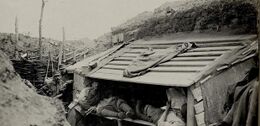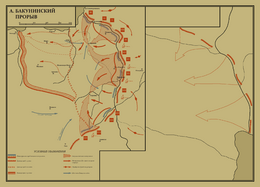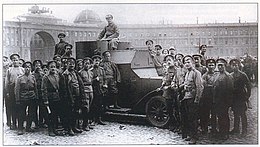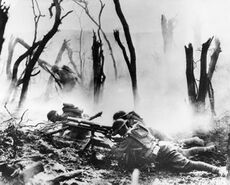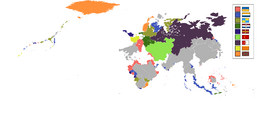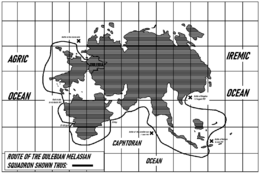Great War (Aurorum)
This article is incomplete because it is pending further input from participants, or it is a work-in-progress by one author. Please comment on this article's talk page to share your input, comments and questions. Note: To contribute to this article, you may need to seek help from the author(s) of this page. |
| Great War | |||||||
|---|---|---|---|---|---|---|---|
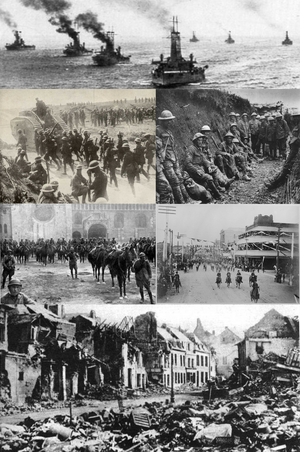 (Clockwise from the top)
| |||||||
| |||||||
| Belligerents | |||||||
|
X |
X | ||||||
| Commanders and leaders | |||||||
|
|
| ||||||
| Strength | |||||||
|
Total: 3,920,294 |
Total: 10,023,000 | ||||||
| Casualties and losses | |||||||
|
Military dead: 495,204 Military deaths by country |
Military dead: 1,736,852 Military deaths by country | ||||||
The Great War, also known as the Great Berean War or the World War, was a significant global conflict primarily between nations in Siantria and Telmeria in Berea and overseas in Caphtora and Pamira, that lasted from 1910 to 1916. Having reached a never before seen scale, it led to the mobilisation of more than 20 million military personnel, making it one of the largest wars ever fought. With an estimated three million combatants and one million civilian deaths as a direct consequence of the war, it is also one of the deadliest conflicts in history. The conflict began on September 7, 1911 following X. It lasted until the unilateral surrender of remaining X powers on May 29, 1916 and peace was declared following the Treaty of Lehpold in early 1917.
TBD
The Continental War at large was a political, economic, cultural, and social turning point for the world. it is generally considered to mark an end to the age of colonial empires in Berea, and saw the dissolution of multiple influential states and the deterioration of others' powers. The war and its immediate aftermath saw a number of revolutions and uprisings in Dulebia, Cuthland, Mascylla, and X. Through the political instability, the Big Three (Albeinland, Lavaria and Mascylla; the principal X members and war victors) emerged their power as great powers and imposed their demands on the defeated enemies in a treaty drafted and signed in 1917—the Treaty of Lehpold. Ultimately, the intergovernmental organisation of the Assembly of Nations was founded to spearhead international cooperation and to prevent another large-scale conflict.
Background
| Events leading to the Great War | ||||||||||||||||||||||||
|---|---|---|---|---|---|---|---|---|---|---|---|---|---|---|---|---|---|---|---|---|---|---|---|---|
 | ||||||||||||||||||||||||
|
||||||||||||||||||||||||
Political atmosphere and ambitions
Arms race
Tensions in Berea
Prelude
The war
Dulebian and Cuthish ambitions for Rovina
Western Front
Dulebian offensive and entrenchment
The armed conflict in the west between the Dulebian and Lavarian armies began on 25 September 1911, 15 days after the declared full mobilization of Dulebian forces. According to the Dulebian pre-war plan, Operation XX, more commonly known as Operation Rassvet, the Dulebian army was almost entirely stationed on the Lavarian border, with the bulk of the forces situated to the south on the Volynsk plain. The Dulebian command left its northern flank relatively weakened, and planned to use the river Lena as a natural barrier and defence frontier. This positioning of the Dulebian forces was used to lure the Lavarian forces to attack on that part of the front, leaving the south mostly undefended against the main Dulebian advance.
The Dulebian right flang was ordered to retreat towards Lena on 26-28 September, this retreat was followed by a Lavarian attack, as planned by the Dulebians. Then, on 29 September, the Dulebian offensive was launched on the left flank by the 2nd Field Army of General Kuznetsov and 3rd Field Army of General Bakunin. The two armies met severe Lavarian resistance on the river Lena, where the Lavarians constructed a fort near the town of Granita. The siege of Granita was the first major battle of the campaign, and slowed the Dulebian advance by two days, giving time for Lavarian command to form new army in the south and march it to the Dulebian border. Simultaniously with the armies of Kuznetsov and Bakunin, 4th Field army under Birulyov, originally kept as reserve to protect the southern frontiers of Dulebia against possible intervention from the Gurkhan empire, was ordered to cross the Lavarian border and attack the Lavarian reinforcements marching from the south, protecting the left flank of 2nd and 3rd armies. The advance of Bakunin and Kuznetsov was halted near the city of Montalvia; the Dulebian forces, who managed to march almost 120 km into Lavaria in less than a week, overstretched their supply lines and the soldiers were exhausted from the rapid advance. The communication lines of the Dulebian forces have not been established. However, the Lavarian forces already started to regroup and a significant portion of their armies were stationed near Montalvia. Facing the risk to lose momentum, Bakunin ordered his forces to cross river Montalvia and mit the Lavarians head-on without reinforcements or an established supply chain. In the resulting Battle of Montalvia, Dulebia faced the first major defeat in the campaign, and its advance was stalled.
Following the Dulebian defeat at Montalvia, the Gurkhan empire, which remained neutral since the start of the war, declared war on Dulebia and invaded the Muromo-Pomorsk Kingdom on 4 March, meeting almost no resistance as all Dulebian forces were sent to the Western front. These events forced the Dulebian command to stop all advances and initiate a regrouping of its forces. General Milyukov, commander of the 1st army on the Dulebian right flank, who sat in defence behind Lena since the start of the campaign, was ordered to attack and push towards Aniarro as it was believed the Lavarian presense there was limited after the regrouping of Lavarian forces near Montalvia. At the same time, 2nd army of Kuznetsov, which already managed to establish stable supply chain, received orders to turn north and connect with Milyukov, attempting encirclement of the Lavarian forces between Bakunin's 3rd army and the Karsk sea coast. Lavarian forces attempted a similar maneuver to encircle the advancing forces of Milyukov. As both forces raced towards the Karsk sea, they had to leave significant amount of forces on the newly-forming frontlines in order to protect their flanks from possible encirclement attempts by their opponent. As a result of this operation, the frontline was stretched even further and in the end it was stalled; both Lavaria and Dulebia found themselves in a stalemate and began entrenching to preserve their current positions.
Winter offensive of 1912 and the frontline stall


The Dulebian forces were very disorganised after the defeat at Montalvia and the following race to the sea, and suffered from very low morale due to the heavy casualties of the first weeks of the conflict. The early advances in Lavaria led to the destruction of the rail and road network, leading to serious problems with supply on the Dulebian side. Besides that, the Lavarian forces, which experienced even heavier casualties, managed to finish their mobilization in early December, and planned a winter counter-offensive in January on the northern section of the front, where the Dulebian defence seemed the weakest. Lavarians concentrated a vast force of almost one million men on the Aniarro-Montalvia section on the front, and launched an offensive on 31 January 1912. Dulebian High Command, due to its inability to request troops from the Southern Front, was forced to call for a retreat back to the Dulebian border and further inland to the river Lena, as was initially planned in case of a failure in the beginning of the war. During their retreat, Dulebian forces deployed scorched earth tactics and completely destroyed the infrastructure of the Guefa region. Regardless of their enemies' retreat, Lavarian forces met heavy resistance during their advance, and lost almost half of the initial force upon reaching the river Lena. They were forced to stop at Lena, since they didn't have the manpower to cross the river and meet the heavy pre-war defence line of the Dulebian empire on the right bank. At the same time, Lavarian attempts to also destroy the Dulebian forces on the southern section of the front ended as complete disaster. As a result of the Winter offensive, Lavaria lost 650,000 men dead, wounded or missing. The deployment of scorched earth tactics by the Dulebians left most of of the frontline completely worthless, hard to defend, and forced Lavaria to waste a vast amount of resources to repair the destroyed infrastructure. All these factors initially made it hard for Lavaria to perfom fast relocations of troops as it could in 1911. The frontline stalled after the Winter offensive for the next year.
Both sides needed several months to recover from the Winter offensive. Between March and December 1912, Dulebian forces under Bakunin attempted to cross Lena three times, but all resulted in a bloody failure. These crossings are now known as the Three Battles of Ust-Borovsk. Identical attempts of Lavarian forces on the southern section of the front, namely the Armala Offensive of July-October 1912 resulted in similar failures, with the Lavarians managing to gain only a small portion of land on the Armala gulf coast of little strategic value, at the expense of 50,000 dead Lavarians. The prolongued trench warfare of 1912 and the resulting stalemate of the Western front in that period, however, had a serious effect on the living conditions of the soldiers in both armies. Diseases like flu, trench fever, on par with numerous parasytes like body lice, psychological traumas and disorders like shell shock, and traumas caused by the armed action itself, especially by chemical weapons like chlorine and mustard gas both significally lowered the troop morale and caused thousands of casualties even outside of combat. The low morale in the Dulebian army eventually led to the spread of various radical political ideas and unrest among the troops and their families at home. Undercover political powers, most notably the far-left communists of Viktor Shchyukin, used the situation to agitate against the war and for a revolution among the frontline troops. As the war progressed, these ideas became more and more popular on the Western front, where the Dulebian empire was the least successful during the conflict. This eventually led to the Dulebian revolution in 1914.
Bakunin's offensive and the Dulebian revolution
The front stalemate continued into 1913, with both sides failing to win decisively. By February 1913 Mikhail Bakunin, the commander of the Dulebian fourth army, proposed a shock attack on the whole length of the front with the usage of brand new tactics for the era. Bakunin was promoted to field marshal and commander of the whole Western front in March 1913, his plan was accepted by the emperor himself, and mass mobilization in preparation for the operation commenced in mid-March. The mobilization was finished on the 15th of May, 1913. Almost 5.3 million men were mobilized, which was equal to 21% of the Dulebian pre-war population. 3 million men were stationed on the Western front on two sections, with the majority of the manpower focused in the north behind the river Lena, where the frontline stood since 1912. The operation was planned to be launched in August 1913, however, due to several defeats of the Cuthish forces against Mascylla and the information about three Lavarian armies being transported to aid Mascylla on the Northern front, Bakunin was forced to launch the offensive on 26 May, 1913.
Dulebian divisions crossed the Lena in the morning of 26 May, and managed to inflitrate the Lavarian trenches on the left bank of the river in several points of the front, most notably at Ivanovo and Ust-Borovsk. Dulebian forces failed to cross Lena in several places, where the Dulebian casualties reached 5,000 in the first day of the operation. Nevertheless, until 31 of May, Bakunin had a stable lodgements in three sectors of the ront, from which the Dulebian forces continued their advance. The key cities of Bravara and Baranca were reached and captured already before 10 June, and the rapid advance continued throughout June. Dulebian forces were forced to stop only at Aniarro, the capital of Lavaria, on 31 June. In the same time, at the southern front the Armala offensive was launched almost immediately after the Bakunin offensive, with the key objective of reaching Armala, key port of the Lavarian navy. Dulebian forces on this part of the front were commanded by General Kirilov, who was not as experienced in maneuver warfare. s a result, Dulebia had only minor success in the Armala offensive, only breaking 100-150 km into Lavarian positions, while facing almost the same amount of casualties as the sector under Bakunin.
Bakunin's offensive is seen as the peak of Dulebian effort in the Great war, and is often named as the breaking point in the war for the country. On one side, the huge success of the operation can be explained by the outstandingg tactics proposed and executed by Bakunin: Dulebian forces relied on short, accurate artillery barrages, rapid advances of small specialist groups followed by the main forces, a tactic later known as infiltration. Armoured vehicles like armoured cars, light and mobile artillery pieces, the extensive use of early improvised self-propelled guns, and the first active usage of air support in the war, and the attempt to use highly-motorized supply vehicles, all are seen as major contributors in the Dulebian victory on tactical level and would later become the basis for the Dulebian shock and infiltration tactics of the mid-20th century. Bakunin himself would become a renowned supporter of the idea of modern warfare and a pioneer of the usage of tanks in the Dulebian People's Army after the Dulebian civil war. On the other side of the coin, however, are the casualties suffered by Dulebia, which were the highest since the beginning of the war, reaching 450,000 dead, wounded or missing by July 1913. On par with previous low morale of the Dulebian forces, the heavy casualties in the operation and the limited success of the Armala offensive, led to first riots in the troops. To worsen the situation, in September 1913 Bakunin and most of the veterans of the operation were transferred to the Valimian border in preparation for Operation Luch, while the Western front was given to Field Marshal Ilya Shchors, the old commander of the Army Group North who showed little-to-no success against Valimia ever since the start of the war, and is generally described as a poor commander who refused to implement the new technologies introduced during the conflict, relying on outdated cavalry attacks and mass infantry doctrine. The breaking point was the defeat of Dulebia in the Battle of Aniarro, where the forces of Shchors failed to cross the river Aniarro, and suffered from heavy casualties, the heaviest inflicted to Dulebia in a single battle since the beginning of the war. This led to the outbreak of the Dulebian Revolution in February 1914 in Ulich and Kamianets. The royal family was arrested by the revolutionaries on 13 February, and the Dulebian Civil War begun the same month between royalists and radical communist revolutionaries under Shchyukin. In these conditions, the Western front collapsed in February, a situation used by Lavaria to start a massive offensive, which saw very limited resistance from Dulebians. Lavarians crossed Lena by March 1914, and even besieged Spassovsk and Novocherepovets. The Dulebian communist party under Shchyukin, which needed to focus all of its forces in the civil war, asked for peace.
Following the Ulich peace treaty of 1914, Dulebia gave up all of the territory captured since 1911, the city of Bravana, captured by Dulebians in 1870, and most of its territories on the Endotheric sea, most notably the Muromo-Pomorsk kingdom. The defeat of Dulebia and the collapse of the Western front left Cuthland as the last major combatant in Berea. The fall of Dulebia led to the collapse of the Cuthish effort in less than a year, the war ended in 1915.
Dulebian cruiser hunters
Karsk sea
Eastern Theatre
Northern Front
Cuthish advances
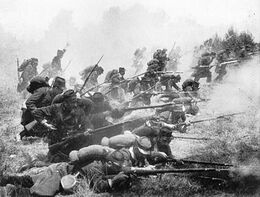
The Northern Front was one of the main theatres of war during the Great War. Following the outbreak of war in September 1910, the Cuthish army opened the Northern Front by first invading the cities of Bad Ülerst and Saarow, which prompted the Mascyllary Kingdom to hastily muster their defences without prior tactical decisionmaking. Therefore, the Cuthish was able to penetrate Mascyllary defences at their border and sweep into the Fanian Plain, quickly gaining military control over important industrial regions in Mascylla. The First Battle of Augusthal proved to be the backbone of any further advances and the obliteration of large-scale Mascyllary military resistance for half a year.
With too little forces set up in time and a chaotic retreat as a result, Mascylla suffered heavy territorial losses in the first months and year of the war. Having reached an unbearable toll on Mascyllary morale and resources, government officials began demanding for a peace truce. However, the tide was turned dramatically in the Battle of Lückwalde and by pure chance with the destaster at Marienfelde where a large portion of the Cuthish forces were swiftly wiped out and saving Königsreh in the process. With Mascylla beginning to hold ground against Cuthland, the front now established between Pereuth on the coast of the White Sea to Konreid at Lake Sigismund began to solidify, despite costly efforts by both sides to lift the stalemate. Furthermore, numerous attempts to open a second front in southern Gothia remained ineffective.
By the end of 1911, the opposing forces were left confronting each other along an uninterrupted line of entrenched positions in central Mascylla. Since the Cuthish were able to choose where to stand, they normally had the advantage of the high ground; in addition, their trenches tended to be better built, since Mascyllary trenches were initially intended as "temporary," preparatory to breaking the Cuthish defences.
Trench warfare and progress of the war
Between 1913 and 1914 several offensives along this front were tried. The attacks employed massive artillery bombardments and waves of infantry divisions. Entrenchments, machine gun emplacements, barbed wire and artillery repeatedly inflicted severe casualties during attacks and counter-attacks and no significant advances were made. Among the most costly of these offensives were the Second Battle of Augusthal, in autumn of 1913, with a combined 600,000 casualties (estimated), the Battle of the Rohrn beginning in Summer of 1914, with more than a million casualties (estimated), and the Battle of Seifritz, in 1915/16, with 487,000 casualties (estimated). Gun fire wasn't the only factor taking lives; the diseases that emerged in the trenches were a major killer on both sides. The terrible living conditions were the origin of a number of diseases and health issues as trench foot, shell shock, blindness/burns from mustard gas, lice, trench fever, cooties (body lice) and other.
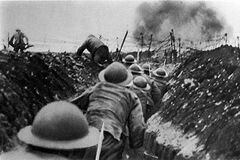
To break the deadlock of trench warfare on the Northern Front, both sides tried new military technology advantages, including poison gas as part of gas warfare, the introduction of military aircraft, and the development of tanks by Mascylla in 1914, essentially contributing to the resolve of trench warfare in the war. The adoption of better tactics and the cumulative weakening of the armies in the west led to the return of mobility in 1916. The Cuthish Storm Offensive, beginning in 1916, led to the devastation of entire regions and further heavy casalties without any advances made, beginning with what is described as a "blunting war". Using short, intense "hurricane" bombardments and infiltration tactics, the Cuthish and Mascyllary armies moved nearly 100 kilometres (60 miles) back and forth to the west and east, the deepest advance by either side since 1910, but the result was indecisive and very costly on human lifes and material used.
The unstoppable advance of the Mascyllary armies during the Three Months Offensive in 1916 caused a graduating collapse of the Cuthish armies and finally persuaded the Cuthish commanders that defeat was inevitable. During the offensive, Temaria declared its independence, aiding Mascyllary forces as they advanced into Cuthland. The offensive was greatly effective, and by 1916 Mascyllary armies had advanced deeply into Cuthish territory and to the cities of Cingsham and Alderport. The Cuthish government surrendered in the armistics of 29 May 1916, and the terms of peace were settled by the Treaty of Lehpold in 1917.
Southern Front
Early Gurkhan advances
Landings at Balchevsk
Collapse of the Gurkhan empire
Other fronts
Melasia
Since the outbreak of the war, Dulebia was unable to reinforce the small garrison of merely 2,000 Dulebian soldiers and 3,000 local policemen stationed in Dulebian Melasia. This was used by Mascylla, which attacked the islands and besieged the port town of Aleksandrovsky, the most important city in the colony, which was also the best-defended settlement outside Dulebia. The small Mascyllary Melasian squadron met heavy resistance from the coast guard of the port, was composed of ten gunboats and two armoured cruisers. Between 12-15 October 1911, the Mascyllary colonial squadron under Admiral Alfred, Crown Prince of Welsbach, attacked the Dulebian squadron under Admiral Bokalov and shelled the city of Aleksandrovsky. During the battle, the Mascyllary forces lost one cruiser, while Bokalov lost four gunboats to enemy fire, with three more being damaged and one being scuttled. The two cruisers of Bokalov managed to escape the city harbour under the cover of night on 16 August and moved to the town of Takawa. Left unprotected from the sea, the city was besieged from the Mascyllary forces, but refused to surrender for two weeks. The forces of the Crown Prince attempted two direct attacks against the fortified walls of the city, both times failing and suffering from serious casualties. In 16 days since the beginning of the siege, the commandant of Aleksandrovsky, Vitaly Klugenfort, decided to give up the fortress because of the starvation of his forces, which were left without supplies. Mascyllary forces continued to Takawa, where they met no resistance from the small garrison. At Kalintan, 2,500 Mascyllary soldiers met a Dulebian garrison of 520 soldiers and 280 policemen, who barricaded themselves in the town hall and refused to surrender. After a several hour fight, the town hall was captured and the remainder of Dulebian troops were captured.
In desperate attempt to save their colony in Melasia, Dulebian High Command dispatched a part of the Karsk sea fleet while it was on its way to the Karsk sea gate to take part in the battle, a decision which, according to some historians, proved vital for the outcome of the battle. The expeditionary squadron under Admiral Glazkov refueled in the Carra Republic, and later sailed around Albeinland on route to Melasia. The squadron consisted of seven ships: two dreadnoughts, four destroyers, and one of the three newest battleships of the country, Admiral Rzhanevsky. The squadron stopped for another refueling in Caphtora, and later harassed allied shipping in the Caphtoran ocean, raiding several Lavarian colonial ports and shelling the city of X in Eastern Caphtora. Unaware of the force of the squadron, Mascylla sent Admiral XXX along part of the Mascyllary Melasian squadron to intercept the Dulebian ships in the Caroline sea. In the Battle of Caroline sea, the Dulebian squadron sunk 3 Mascyllary destroyers and one pre-dreadnought, effectively wiping out half of the Mascyllary navy in Melasia. The Dulebian squadron reached the Tarokan sea two weeks later, only to find that the city of Vostok, the last Dulebian port in Melasia, was already partially captured by the forces of General Karl Georg von Pritnitz. The ships of Glazkov retrieved several hundred refugees and soldiers from the city, added the last remaining cruiser of Bokalov to the squadron and fled to Nanzhou to refuel. On their way through the Tarokan strait, they were intercepted by the remainder of the Mascyllary Melasian squadron under Helmuth von Kraisach, in a daring attack. Von Kraisach expected the Dulebian ships to be damaged since the engagement in the Caroline sea and to be running low on ammunition. However, his entire fleet was sunk in the battle that lasted three hours; Dulebia lost one destroyer and several other ships took light damage, but were able to continue to Nanzhou. Von Kraisach died during the battle when his ship, the pre-dreadnought MSS Markgraf was critically hit in the casemate and suffered from an explosion of the ammo rack on the opening hour of the battle.
Nanzhou
Caphtora
Aftermath
Peace treaties and geopolitical changes
Treaty of Lehpold
Main article: Treaty of Lehpold
See also
- ↑ Prior to the Bakunin's Breakthrough in May 1913


